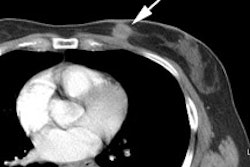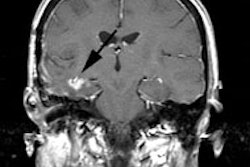J Clin Oncol 1998 Oct;16(10):3375-9
Detection of bone metastases in breast cancer by 18FDG PET: differing
metabolic activity in osteoblastic and osteolytic lesions.
Cook GJ, Houston S, Rubens R, Maisey MN, Fogelman I.
PURPOSE: 99mTechnetium methylene diphosphonate (99mTc MDP) bone scintigraphy is
currently the method of choice for the detection of bone metastases, but
18F-fluoro-deoxy-D-glucose positron emission tomography (18FDG PET) offers
superior spatial resolution and improved sensitivity. We have compared 18FDG PET
with 99mTc MDP bone scintigraphy in patients with skeletal metastases from
breast cancer and have analyzed the data in subgroups based on radiographic
characteristics of lesions. PATIENTS AND METHODS: Twenty-three women with breast
cancer and confirmed bone metastases were studied with both 99mTC MDP bone
scintigraphy and 18FDG PET, and the number of lesions detected and the
quantitation of uptake (standardized uptake values [SUVs]) of 18FDG in
osteolytic and osteoblastic metastases were compared. Survival was compared for
both lytic and blastic bone metastases and for patients with high and low
accumulation of 18FDG. RESULTS: 18FDG PET detected more lesions than 99mTc MDP
scintigraphy (mean, 14.1 and 7.8 lesions, respectively; P < .01). However,
18FDG detected fewer bone metastases compared with 99mTc MDP scintigraphy in a
subgroup of patients with osteoblastic disease (P < .05). Higher SUVs were
observed for osteolytic than osteoblastic disease (mean, 6.77 and 0.95,
respectively; P < .01). Survival was lower in patients with osteolytic
disease compared with the remainder (P=.01). A difference in survival was not
found for those patients with high SUVs (> 3.6; P=.4). CONCLUSION: 18FDG PET
is superior to bone scintigraphy in the detection of osteolytic breast cancer
metastases, which led to a poorer prognosis. In contrast, osteoblastic
metastases show lower metabolic activity and are frequently undetectable by PET.
The biologic explanation for this observation remains to be elucidated.





